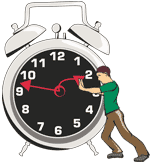4/2/2005
The Daylight Savings Time Switch and Increased AccidentsA study shows an increase in traffic accidents immediately following the spring daylight savings time shift.

When clocks are set back an hour in the spring, accidents go up according to a 1998 study of the effect of daylight savings time. Sleep deprivation is considered the most likely cause of a 17 percent increase in accidents on the Monday following the time change. The study also found no significant reduction in accidents in the fall when clocks are set back an hour.
"Just because a person has the opportunity to sleep for an addition hour does not mean that people actually will go to sleep on time," the study suggests. "Many may spend that extra hour socializing or watching television."
The study used data from NHTSA's Fatal Accident Reporting System from 1986 to 1995. The same researcher had concluded in 1996 that sleep deprivation led to a 6.6 percent increase in non-vehicle deaths after the spring change, with an insignificant 1.5 percent decrease following the fall clock change.
Key Statistic:
Next we compare the total of traffic fatalities for the Monday immediately following the DST shift with the pooled frequency of accidents for the previous and following Mondays. The spring DST shift (where one hour of sleep is lost) shows the expected increase in accidents with relative risk (RR) of 1.17 [95% CI=1.07/1.29, p2(1)=10.83, p < 0.001]. This 17 percent increase is larger than that observed in previous studies. The same analysis conducted for the fall DST shift, however, produces an insignificant reduction in traffic deaths [RR=0.97, 95% CI=0.89/1.07, p2(1)=0.29, ns.].
Article Excerpt:
Taken together then, these data are consistent with the hypothesis that as a society were are sufficiently chronically sleep deprived so that a small decrease in sleep duration, such as that which occurs with the spring shift to DST, can significantly increase accident susceptibility.Source: Sleep Deficit, Fatal Accidents, and the Spring Shift to Daylight Savings Time (Department of Psychology, University of British Columbia, 1/1/1998)
Permanent Link for this item
Return to Front Page


